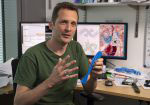

Our group develops RELION, the most widely used open-source software package for electron cryo-microscopy (cryo-EM) structure determination. We also use our software to study the structures of amyloid filaments from neurodegenerative diseases like Alzheimer’s and Parkinson’s. Depending on the preference of the candidate, the PhD project could be either computational or experimental.
Possible computational projects in image processing developments could involve the analysis of dynamically flexing molecules or the development of next-generation refinement code for single-particle analysis, or the development of new algorithms for tomogram reconstruction, the identification of molecules in tomograms, or sub-tomogram averaging in electron cryo-tomography (cryo-ET).
The experimental project would involve performing correlative light and electron microscopy experiments to perform cryo-ET on cellular models of Alzheimer’s disease that have been established in our group. Although this project would still include a fair amount of computational image processing, it would mostly use, rather than develop, the methods implemented in RELION. The student would also spend a lot of time in the wetlab and behind microscopes.
References
Automated model building and protein identification in cryo-EM maps
Nature 628(8007): 450-457 (2024)
Data-driven regularization lowers the size barrier of cryo-EM structure determination
Nature Methods 21(7): 1216-1221 (2024)
DynaMight: estimating molecular motions with improved reconstruction from cryo-EM images
Nature Methods 21(10): 1855-1862 (2024)